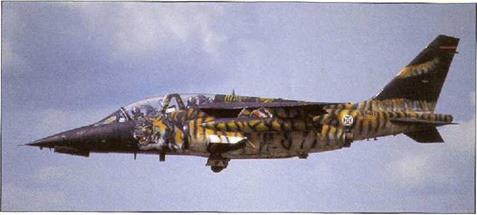Dassault/Dornier Alpha Jet
|
|
I |
n July 1969 France’s Dassault ana’ Germany’s Dornier agreed to jointly develop and produce a new advanced trainer. The resultant Alpha Jet had swept shoulder-mounted wings, two Larzac turbofans and stepped tandem cockpits. French and German equipment fits varied considerably. Because the Luftwaffe decided to continue its military pilot training in the US, its requirement for the Alpha Jet moved on to a light grojnd-attack replacement for its Fiat G91R/3s. This necessitated advanced nav/attack systems, ‘nciuding a twin-gyro INS, Doppler navigation radar, HUD, and a beily- mounted 27-mm Mauser cannon pod (instead of the 30-rr. m DEFA pod found on French Alphas). The initial order for 200 aircraft for each country was ultimately reduced to 175.
Alpha Jet development was finally approved in February 1972, and two prototypes were fiown in France ano Germany in 1973 and 1974 respectively French production Alpha Jet Es (Ecole) began flying in November 1977 and service trials commenced in 1978. German production started with the first Alpha Jet A (Appui Tactique) flying in April 1978. In 1993 Germany retired ah but 20 German Alphas (for lead-in training for Tornado crews) and a total of 50 Surplus aircraft was transferred to Portugal Initial exports were mace to Belgium (33). Egypt (30 including 26 locally-assembled Alpha Jet MS 1 trainers). Ivory Coast (12). Morocco (24), Nigeria (24), Qatar (six) and Togo (five).
In addition to Portugal refurbished former – Luftwaffe Alpha Jet As have been sold to Thailand and the LJK. In Thailand 25 aircraft will serve as lead-in fighter trainers while12 were acquired by Britain’s Defence Evaluation and Research Agency
For lead-in fighter training and light ground – attack, Dassault launched the Alpha Jet IMGEA (Nouvelle Generation Appui/Ecole) or Alpha Jet MS2 programme in 1980. It featured unrated engines and new avionics including an INS, CRT HUD and laser rangefinder, plus provision for Magic AAMs. Customers included Cameroon (seven) and Egypt (15).
In the early 1990s Dassault proposed an MS2- derived Alpha Jet 3 Advanced Training System, or Lancier, with twin multi-function cockpit displays for mission training with such sensors as AGAVE or Anemone radar, FUR, laser, video ano ECM systems, plus advanced weapons. This version may form the basis for a possible upgrade now being considered for the Alpha Jet Es still :n Armee de Г Air service.
The blunt-nosed Alpha Jet E is still the standard jet trainer for France’s Armee de /’Air, but it will have to be upgraded to function in the Rafale era.
|













